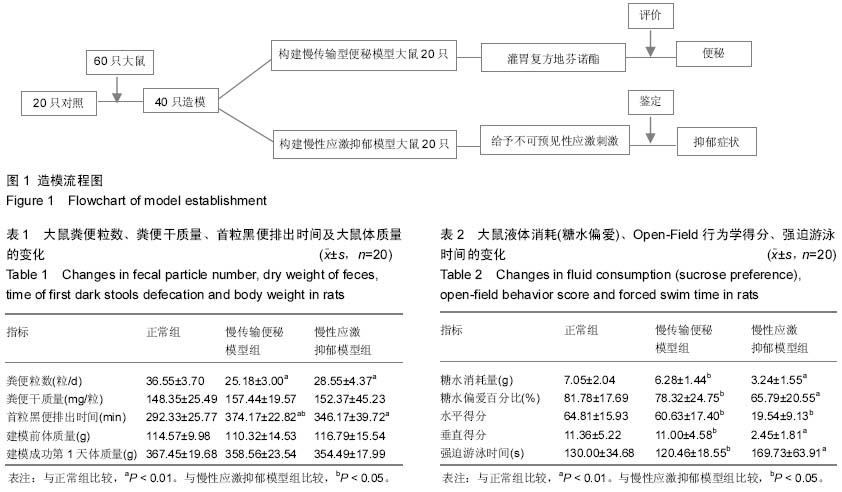| [1] 柯美云.慢性便秘的诊治指南[J].中华消化杂志,2004,24(1): 39-40.
[2] 郭晓峰,柯美云,潘国宗,等.北京地区成人慢性便秘整群、分层、随机流行病学调查及其相关因素分析[J].中华消化杂志,2002, 22:637-638.
[3] 温丽雅,陈长香,王静,等.老年人便秘及其影响因素的研究[J].现代预防医学,2008,35(15):2827-2829.
[4] Murray CJ, Lopez AD. Alternative projections of mortality and disability by cause 1990-2020. Global Burden of Disease Study. Lancet. 1997;349(9064):1498-1504.
[5] 阚志超,姚宏昌,龙治平,等.天津市成年人慢性便秘调查及相关因素分析[J].中华消化杂志,2004,24(10):612-614.
[6] MerkelI S, Locher J, Burgio K, et al. Physiologic and psychologiccharacteristics of elderly population with chronic constipation. Am J Gastroenterol. 1993,88(11):1854-1859.
[7] 夏瑾,陈建永,潘峰,等.功能性便秘患者社会心理状况分析及护理对策[J].中华护理杂志,2006,41(3)207-210.
[8] 丁元伟,吴婉清,陈德,等.焦虑抑郁状态功能性便秘患者肛门直肠动力和直肠感觉变化[J].广东医学,2010,31(18):2432-2433.
[9] 徐英.老年期精神病患者便秘的危险因素与护理措施[J].中国民康医学,2011,21(3):377-378.
[10] 乔静.功能性便秘伴发抑郁症84例研究[J].中国医药指南,2001, 9(8):216-217.
[11] 王建醒,周丽,徐华峰,等.慢性应激大鼠抑郁模型的建立及其评价[J].齐齐哈尔医学院学报,2006,27(6):644-646.
[12] 智会,袁维堂.水通道蛋白3,4,8在大鼠慢传输型便秘型便秘模型结肠黏膜中的表达[J].中华胃肠外科杂志,2011,14(6): 459-461.
[13] 谢振年,李东冰,贾小强,等.焦虑和抑郁在慢传输型便秘患者发病过程中的作用评估初探[J].世界中医药,2013,9:1033-1035.
[14] 陆凤清,陈东明,黄文杰.不同居住环境便秘老人抑郁情绪的调查[J].国际护理学杂志, 2013,9:1937-1938.
[15] 丁淑平,郝习君,陈长香.老年人便秘与焦虑、抑郁发生的相关性分析[J].现代预防医学,2009,36(18):3488-3489.
[16] Cheng C, Chan AO, Hui WM. Coping strategies, illness perception, anxiety and depression of patients with idiopathic constipation: a population-based study. Aliment Pharmacol Ther. 2003;18(3):319-326.
[17] 张瑛华,徐丽姝,叶瑞繁.老年慢性便秘与精神心理因素关系的研究[J].实用医学杂志,2007,23(13):2030-2031.
[18] Emmanuel AV, Mason HJ, Kamm MA. Relationship between psychological state and level of activity of extrinsic gut innervation in patients with a functional gut disorder. Gut. 2001; 49(2):209-213.
[19] Bouchoucha M, Hejnar M, Devroede G. Patients with irritable bowel syndrome and constipation are more depressed than patients with functionalconstipation. Dig Liver Dis. 2014;46(3): 213-218.
[20] Koloski NA, Jones M, Wai R. Impact of persistent constipation on health-related quality of life and mortality in older community-dwelling women. Am J Gastroenterol. 2013; 108(7):1152-1158.
[21] Albiani JJ, Hart SL, Katz L. Impact of depression and anxiety on the quality of life of constipated patients. J Clin Psychol Med Settings. 2013;20(1):123-132.
[22] 程红彦.综合心理干预对老年习惯性便秘患者心理状态和便秘程度的影响分析[J].中国现代药物应用,2013,7(12):216-217.
[23] 方小满,陈长香,杨卫.唐山市老人院老年人便秘与抑郁患病及相关性[J].中国老年学杂志,2013,33(21):5432-5432.
[24] Garvey M, Noyes R Jr, Yates W. Frequency of constipation in major depression: relationship to other clinical variables. Psychosomatics. 1990;31(2):204-206.
[25] Nervi G, Ceroni P, Bertelè A, et al. Multidimensional appraisal in patients suffering from chronic idiopathic constipation. Acta Biomed Ateneo Parmense. 2001;72(1-2):45-54.
[26] 段建华,赵洪川.功能性便秘发病机制的研究现状[J].国外医学:消化系疾病分册,2005,25(5):310-313.
[27] 李学锋 ,邹益友.出口梗阻性便秘患者的肛门直肠动力学与精神心理因素研究[J].世界华人消化杂志,2005,13(1):128-129.
[28] Addolorato G, Capristo E, Gasbarrini G, et al. Depression, alcohol abuse and orocaecal transit time. Gut. 1997; 41(3): 417-418.
[29] 贾英田,杨向东,李五生,等.便秘患者242例精神心理特点及相关因素分析[J].中国肛肠病杂志,2013,12:62-64. |
